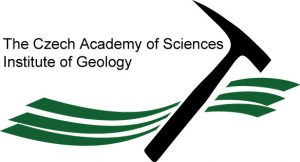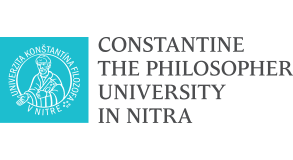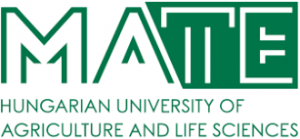Our Arrival to Central Europe
Interdisciplinary project of the Želeč I -Holcase site excavation in the area of the Ondratice sand and gravel mine
In 2022 our research team was successful in receiving a financial support from the Visegrad Fund, which can be used for an archaeological excavation of the Želeč site in Central Moravia.
International team members:
Mgr. Ondřej Mlejnek, Ph.D.: team manager, archaeologist, Excellent Centre of Archaeometry (ERCA), Archaeological Centre in Olomouc, Czech Republic
doc. Mgr. Lenka Lisá, Ph.D.: specialist in geoarchaeology, specifically in micromorphology of sediments, Geological Institute of Czech Academy of Sciences, Prague, Czech Republic
doc. Mgr. Mária Hajnalová, Ph.D.: specialist in archaeobotany, specifically in analysis of plant macroremains, Department of Archaeology, Faculty of Arts, Constantine the Philosopher University in Nitra, Slovakia
dr hab. inż. Piotr Moska: specialist in absolute dating methods, especially in the Optically Stimulated Luminescence (OSL) dating, Institute of Physics, Centre for Science and Education, Silesian University of Technology, Gliwice, Poland
Dr. Ákos Pető: specialist in archaeobotany, specifically in the phytolith analysis, Hungarian University of Agriculture and Life Sciences, Faculty of Agricultural anf Environmental Sciences, Department of Nature Conservation and Landscape Management, Gödöllő, Hungary
History of research:
Palaeolithic site on the border of the cadastral territories of the Ondratice and Želeč villages in the Prostějov area has been well know to the scientific community since the break of the nineteen and twentieth centuries, when Hynek Hostínek, a post officer from Brodek, and Jakub Možný, a farmer from Ondratice, collected first lithic artefacts at this site (Kopecký, 1940; Maška, Obermaier, 1911). A geodesist and amateur archaeologist, Inocenc Ladislav Červinka also collected an assemblage of lithic tools here and in 1907 he conducted first archaeological excavation on this site. According to his notes (Červinka, 1915) an area of 4000 m2 should have been excavated. Although he probably exaggerated, this was for sure the most extensive excavation on this site up to now. In a frame of this excavation two concentrations of orthoquartzite blocks and charcoal pieces interpreted as hearths were excavated. Several thousands of lithic artefacts were allegedly found in their surroundings. Scarce retouched tools were represented by several end-scrapers, leaf points and side-scrapers.
In the interwar period, the main attention of the researchers was paid to the finds deposited in the Moravian Museum, which were found during surface surveys. Large pieces of orthoquartzite were published by Karel Absolon (1936) as so called “Gigatolithen”. Later, it was proved, that most of these tools were in fact cores or pseudo-artefacts (Schwabedissen, 1943; Oliva, 2005). In 1928, Josef Dania, a documentalist in the Moravian Museum, conducted under the supervision of K. Absolon another excavation on this site. The excavated area was 49,5 m2. According to K. Absolon (1935, 10) he managed to unearth a cultural layer with orthoquartzite tools situated under the layer with lithic artefacts made of silicites. According to L. Zotz (1951, 175) J. Dania later mentioned that the orthoquartzite tools were deposited in one layer mixed up with silicite artefacts. Later even K. Absolon mentioned just one cultural layer (Absolon, 1945, 24). The results of next excavation conducted here under a surveillance of Hermann Schwabedissen in 1942 are similarly confusing. While H. Schwabedissen mentioned that they excavated just one cultural layer with artefacts made of both orthoquartzite and silicites (Schwabedissen, 1942, 44), a technician from the Moravian Museum, Emanuel Dania (a cousin of J. Dania), who was present at the excavation, later mentioned that the orthoquartzite artefacts were deposited in a lower layer under a layer containing silicite artefacts (Valoch, 1967, 14). This statement was confirmed by an amateur archaeologist Jan Ječmínek, who was employed at this excavation as a worker. An area of 30 m2 was excavated during this excavation. An excavated lithic collection resembled the surface assemblage (Schwabedisen, 1942).
In the interwar period, Jan Kopecký, a principal in the Brodek elementary school, who cooperated with professional archaeologists K. Absolon and Josef Skutil, become the main collector of lithic tools in the surrounding of Ondratice. He provoked an interest in Palaeolithic artefacts also in one of his pupils, Jan Ječmínek from Ondratice, who became the main collector of lithics in this region after the WWII. His collection deposited in the Moravian Museum substituted the earlier collections destroyed in the fire in the Mikulov castle at the end of the WWII. Apart of rich surface finds, in the afterwar period, the archaeologists were not for a long time able to find in situ layers containing Palaeolithic finds and to verify their position. It was a case of Karel Valoch in 1965, who, together with J. Ječminek, excavated 25 test pits at this site without finding a cultural layer (Valoch, 1967), as well as of Jiří Svoboda in 1977, who excavated nine trenches with a mechanical digger and other several drills using a geologic spiral auger (Svoboda, 1977). Both of them could confirm a local geologic stratigraphy described earlier by Josef Pelíšek (Pelíšek, 1944; Absolon, 1945). Under the plough horizon, there was a loess layer and underneath a layer of fossil soil deposited directly on the bedrock formed by the Miocene sands and gravels. In the central part of the site, the layers in between the topsoil and bedrock were eroded off and the lithic artefacts were deposited directly in the tillage, where they have been collected by generations of local collectors and amateur archaeologists.
In the after-war period, a part of the surface collection was gradually analysed. While Karl Prosche analysed a part of the lithics excavated by I. L. Červinka, deposited in the Halle museum (Prosche, 1960), J. Svoboda analysed an orthoquartzite part of surface collections from the Ondratice I/Želeč site (Svoboda, 1980). Silicite part of surface collections was gradually analysed by several researchers. Martin Oliva analysed an assemblage from a minor concentration of surface finds in the location called Ondratice Ia -Malá Začaková (Oliva, 2004). Lithics from the central location called Ondratice I/Želeč – Velká Začaková/Holcase were analysed for example by Inna Mateiciucová (1989), Zdeňka Nerudová (2015) or Ondřej Mlejnek (Mlejnek et al., 2012), who also described a history of the Palaeolithic research in this region (Mlejnek, 2015, 25-31). The main discussion topic was a question of homogeneity/heterogeneity of surface collection and a question of a number of in situ cultural layers excavated during previous excavations. These research questions were connected with a problem, if it is possible to analyse the orthoquartzite part of the collections together with the silicite part or if these two components represent two chronologically different settlement phases.
During the second half of the 20th century the Ondratice gravel mine has substantially expanded. This expansion destroyed the minor concentration of finds in the Malá Začaková area (Ondratice Ia site) and finally the mine reached the edge of the main surface site Ondratice I/Želeč – Velká Začaková/Holcase. In 2009 the site was visited by P. Škrdla and O. Mlejnek, who managed to find several lithic artefacts at the edge of the mine. Thereafter they excavated three test pits at the finding places of these lithics. Two of them contained several other lithic artefacts together with charcoal layers. Circa 50 metres long Trench 4 was excavated by a mechanical excavator at a place of the second test pit. This trench cut twelve charcoal lenses interpreted as hearths. In a place of one of these lenses, an interdisciplinary excavation took place in between 2010 and 2012. The results of this excavations were later published (Mlejnek et al., 2016; Mlejnek, 2015, 121-134).
The main cultural layer was deposited on the border of the bedrock consisted of the Miocene sands and gravels and overlying ochre soil sediment. Over this sediment there was another brownish soil sediment, Upper Würmian loess and topsoil. Directly in the 4a trench (21 m2) remains of three hearths delimited by blocks of Culmian slate were unearthed. In the surrounding of these hearths 69 lithic artefacts made mainly of Cretaceous spongolites, radiolarites and Moravian Jurassic cherts were excavated. Among retouched tools just an indistinct point was found in situ, a leaf point and an end scraper were found on a heap of a dirt soil from the trench nr. 4 excavated by a mechanical excavator. In 2012 other three trenches were excavated mechanically; test pits 5-10 were dug manually. Two features in a form of pits with diameters of circa 0,4 m were observed in a section of the trench nr. 12. Both of these pits were embedded into the ochre soil sediment from the overlying brownish soil sediment and they were archaeologically excavated (trenches 12a and 12b). Radiocarbon dates from the hearths in the 4a trench circulate around 43 ky BP cal (Initial Upper Palaeolithic). Absolute dates coming from isolated charcoal pieces from fossil soil sediments in the trench 4a and also from pits in the trenches 12a and 12b are younger (33 – 38 ky BP cal). Based on the radiocarbon AMS dating, we could connect this indistinct settlement horizon probably with the technocomplex of Aurignacian. Anthracological analysis has proven that most of the analysed charcoal pieces come from the larch wood, smaller part also from the pine wood. Isolated charcoal pieces were also determined as juniper, Swiss pine and willow (isolated charcoal fragment from the 12a trench). Based on these results, it is possible to reconstruct the wood vegetation of the Early Upper Palaeolithic in central Moravia as a park-like countryside with larch and pine woods on the slopes of the highlands and with steppe or forest-steppe in lowlands around rivers. Juniper could form a bush level in the larch woods or it could also grow as isolated bushes in the steppe or forest-steppe (Mlejnek et al., 2016). Archaeological excavation of the Želeč I – Holcase site conducted in between 2010 and 2012 thus proved a human presence on this spot at least in two periods during the Early Upper Palaeolithic. It has also revealed interesting information concerning a wood species composition during the Early Upper Palaeolithic in central Moravia. However, a lot of research questions remained unanswered. During the planned continuation of this excavation we will try to answer al least some of them.
Research Project:
The main aim of this research project is a continuation of the excavation of this site with a focus on the sediment microstratigraphy and on the absolute dating using the radiocarbon AMS method and OSL method (Piotr Moska). We would like to publish the results of micromorphological and geochemical analyses, which were conducted on the samples from the 2010 season (Lenka Lisá) and we would also like to perform some new samplings for geoarchaeological analyses. An analysis of lithic artefacts found during the excavation will be performed as well (Ondřej Mlejnek). Other methods, such as the anthracological analysis of charcoal pieces from excavated hearths and cultural layers (Jan Novák), phytolith (Ákos Petö) and pollen analysis (Mária Hajnalová) etc. will be performed as well. Possible petroarchaeological analyses will be conducted by Petr Gadas. The excavation of this site performed by the team of the Excellent Research Centre of Archaeometry (ERCA) is planned from 15th to 25th August 2022. Team leader will be Mgr. Ondřej Mlejnek, Ph.D.
References:
Absolon, K., 1936: Über Großformen des quarzitischen Aurignaciens der palaeolithischen Station Ondratice in Mahren. Typologie der s. g. „Gigantolithen“. Práce z Palaeolithickeho odděleni
Moravského zemského musea 42, Brno.
Absolon, K., 1945: Prehistoricky výzkum jeskyně Býčí skály na srovnávacím základě, Brno.
Červinka, I.., 1915: Solutréen-Station bei Ondratitz-Zeltsch (Bezirk Wischau/Mahren). Nepublikovaný dopis uložený v Landesmuseum für Vorgeschichte Sachsen-Anhalt, Halle.
Kopecký, J., 1940: J. Kopecký, Sběratelská činnost Hynka Hostínka v Brodku u Prostějova. Ročenka Národopisného a Průmyslového Musea Města Prostějova a Hané 17, 1940, 53-57.
Maška, K.J., Obermaier, H., 1911: La station solutréenne de Ondratitz (Moravie). LAnthropologie 22, 1911, 403-412.
Mateiciucová, I., 1989: Stará kolekce silicitové industrie z Ondratic I. Nepublikovaná odborná práce uložená na Ústavu archeologie a muzeologie Filozofické fakulty Masarykovy univerzity v Brně.
Mlejnek, O., 2015: Paleolit východních svahů Drahanské vrchoviny. Dissertationes Archaeologicae Brunenses/Pragensesque, 18, Brno.
Mlejnek. O., Škrdla, P., Přichystal, A., 2012: Ondratice I/Želeč – An Early Upper Palaeolithic Site in Central Moravia. Archäologisches Korrespondenzblatt, 42(3), 295-314.
Mlejnek, O., Škrdla, O., Tostevin, G., Lisá. L., Novák, J., 2016: Želeč I (okr. Prostějov / CZ) –the Early Upper Palaeolithic Stratified Site: The Question of the Integrity of the Ondratice I / Želeč Surface Collection. Archäologisches Korrespondenzblatt, 46(1), 1-14.
Nerudová, Z., 2015: Technologický rozbor silicitové industrie z lokality Ondratice I. Acta Musei Moraviae, Scientiae Sociales, 100(1), 3-32.
Oliva, M. 2004: Vyvinutý szeletien z lokality Ondratice Ia – Malá Začakova. Le szeletien évolue du site Ondratice Ia – Mala Začakova. Acta Musei Moraviae, Scientiae Sociales 89, 59-81.
Oliva, M., 2005: Civilizace moravského paleolitu a mezolitu. Za poznáním do muzea, 11, Brno.
Pelíšek, J., 1944: Fosilní půdy na oncophorovych (miocenních) píscích střední Moravy. Příroda 36, 1944, 79-82.
Prosche, K., 1960: K. Prosche, Das Jungpaläolithikum von Ondratice (Mähren) nach der Sammlung des Landesmuseums für Vorgeschichte Halle. In: Arbeiten aus dem Institut für Vor – und Frühgeschichte der Martin-Luther-Universität Halle-Wittenberg 10, Wissenschaftliche Zeitschrift der Martin-Luther-Universität Halle-Wittenberg 9/3 (Halle 1960) 333-364.
Schwabedissen, H., 1942: Untersuchungen auf dem altsteinzeitlichen Fundgelande von Ondratitz, Bez. Wischau. Zeitschrift des Mährischen Landesmuseums N. F. 2, 1942, 43-45.
Schwabedissen, H., 1943: Stand und Aufgaben der Alt- und Mittelsteinzeitforschung im mährischen Raum. Zeitschrift des Mährischen Landesmuseums N. F. 3, 1943, 1-31.
Svoboda, J., 1977: Ondratice, okr. Prostějov, Velká Začakova, Holcase. Nepublikovaná nálezová zpráva uložená na Archeologickém ústavu AV ČR v Brně.
Svoboda, J., 1980: Křemencova industrie z Ondratic. K problému počátků mladého paleolitu. Studie Archeologického Ústavu Československé Akademie věd v Brně, 9, Praha.
Valoch, K., 1967: Die altsteinzeitliche Station im Raum von Ondratice in Mähren. Acta Musei Moraviae, Scientiae Sociales, 52, 5-43.
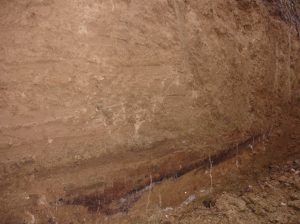
Charcoal lens (hearth) unearthed in a section in the trench nr. 4 in 2009.
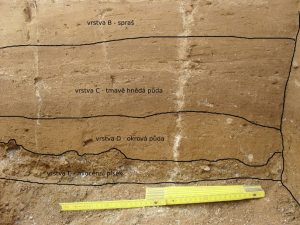
Southern section of the trench 4a in 2011 with a description of layers.
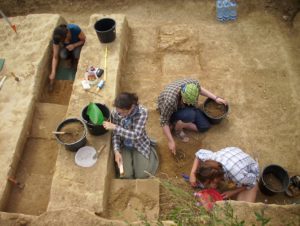
Excavation of the trench 4a in 2012.
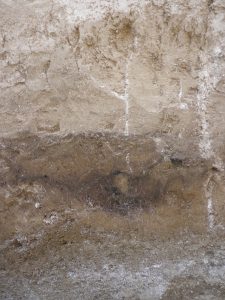
Section of the feature 12a excavated in the trench nr. 12 in 2012.










